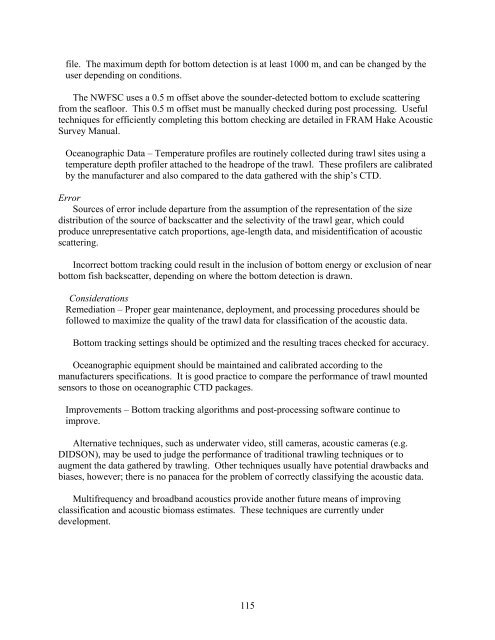NOAA Protocols for Fisheries Acoustics Surveys and Related ...
NOAA Protocols for Fisheries Acoustics Surveys and Related ...
NOAA Protocols for Fisheries Acoustics Surveys and Related ...
Create successful ePaper yourself
Turn your PDF publications into a flip-book with our unique Google optimized e-Paper software.
file. The maximum depth <strong>for</strong> bottom detection is at least 1000 m, <strong>and</strong> can be changed by the<br />
user depending on conditions.<br />
The NWFSC uses a 0.5 m offset above the sounder-detected bottom to exclude scattering<br />
from the seafloor. This 0.5 m offset must be manually checked during post processing. Useful<br />
techniques <strong>for</strong> efficiently completing this bottom checking are detailed in FRAM Hake Acoustic<br />
Survey Manual.<br />
Oceanographic Data – Temperature profiles are routinely collected during trawl sites using a<br />
temperature depth profiler attached to the headrope of the trawl. These profilers are calibrated<br />
by the manufacturer <strong>and</strong> also compared to the data gathered with the ship’s CTD.<br />
Error<br />
Sources of error include departure from the assumption of the representation of the size<br />
distribution of the source of backscatter <strong>and</strong> the selectivity of the trawl gear, which could<br />
produce unrepresentative catch proportions, age-length data, <strong>and</strong> misidentification of acoustic<br />
scattering.<br />
Incorrect bottom tracking could result in the inclusion of bottom energy or exclusion of near<br />
bottom fish backscatter, depending on where the bottom detection is drawn.<br />
Considerations<br />
Remediation – Proper gear maintenance, deployment, <strong>and</strong> processing procedures should be<br />
followed to maximize the quality of the trawl data <strong>for</strong> classification of the acoustic data.<br />
Bottom tracking settings should be optimized <strong>and</strong> the resulting traces checked <strong>for</strong> accuracy.<br />
Oceanographic equipment should be maintained <strong>and</strong> calibrated according to the<br />
manufacturers specifications. It is good practice to compare the per<strong>for</strong>mance of trawl mounted<br />
sensors to those on oceanographic CTD packages.<br />
Improvements – Bottom tracking algorithms <strong>and</strong> post-processing software continue to<br />
improve.<br />
Alternative techniques, such as underwater video, still cameras, acoustic cameras (e.g.<br />
DIDSON), may be used to judge the per<strong>for</strong>mance of traditional trawling techniques or to<br />
augment the data gathered by trawling. Other techniques usually have potential drawbacks <strong>and</strong><br />
biases, however; there is no panacea <strong>for</strong> the problem of correctly classifying the acoustic data.<br />
Multifrequency <strong>and</strong> broadb<strong>and</strong> acoustics provide another future means of improving<br />
classification <strong>and</strong> acoustic biomass estimates. These techniques are currently under<br />
development.<br />
115
















